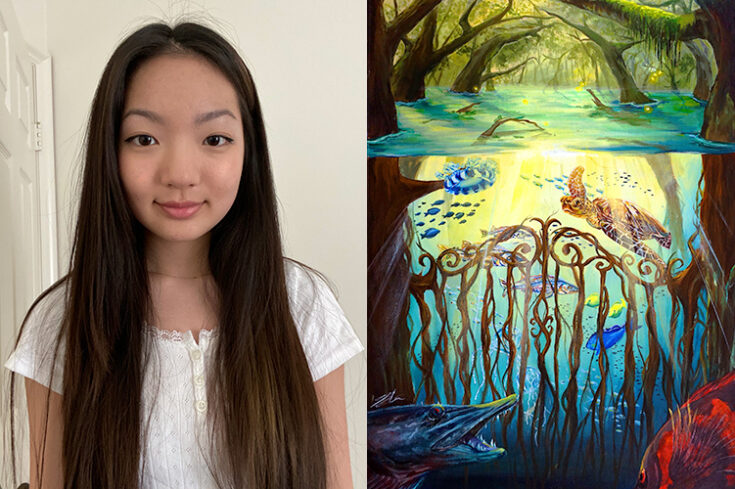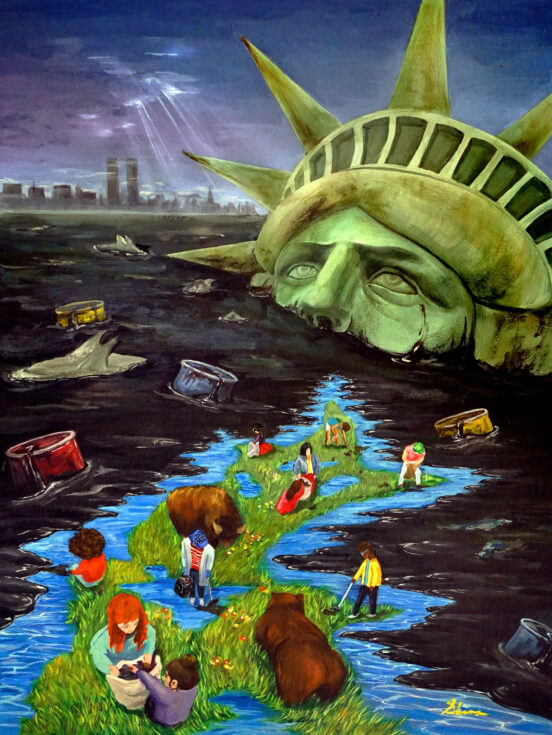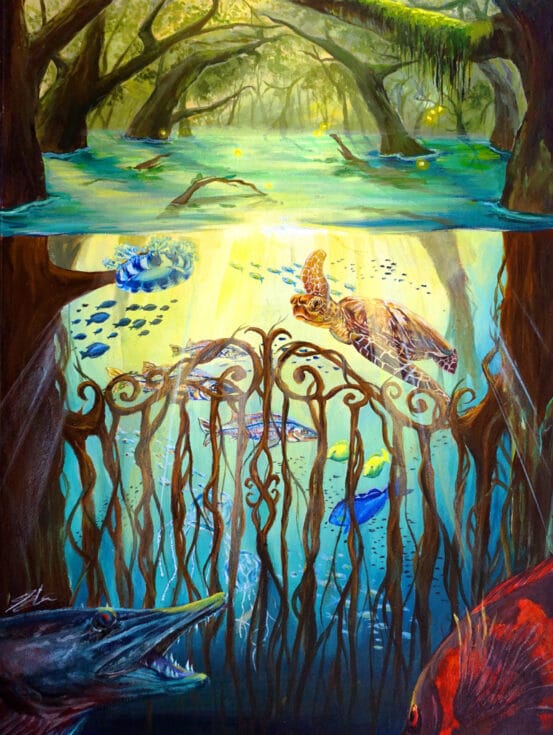Aside from viewing at all the incredible art that we receive during the Science Without Borders® Challenge, one of my favorite tasks is getting to meet the contest winners and their families and teachers. This year I had the pleasure of getting to know Sharon Choi, the first-place winner of our contest for ages 15-19.

Sharon, a 16-year-old student at Sunny Hills High School in Fullerton, California, won for her artwork titled, The Guardians of the Sea. In our interview, Sharon admits that she had no prior knowledge of mangroves, but once she started to research them, she became captivated by the contest theme. Although she learned a lot about mangroves, she decided to illustrate one important aspect of this ecosystem. She revealed how these trees provide protection for many organisms, especially those in the early stages of their life.
Learn more from my interview with Sharon about what inspired her to create her artwork, what she hopes we gain from her piece, and why she wants to conserve the ocean, and so much more. Our conversation has been lightly edited for length and clarity.
Q: What inspired you to create your art piece?
A: After I researched the role mangroves serve in our environment, I ultimately decided to focus on their role as a breeding ground where they protect young fish from predators. I was inspired by digital fantasy realms because I wanted to incorporate a magical, fantasy-like aspect to my piece. I wanted my piece to feel like a welcoming, safe space for different species, so I also derived inspiration from kindergartens that have protective gates surrounding them.
Q: What do you want people to get out of the artwork you created?
A: I think most people hear about the need to conserve coral reefs, but not many people know about the importance of mangroves. I now know that mangroves are equally as important. I hope that my artwork brings awareness of the threats to mangroves and inspires other people to learn more about this magnificent network of roots and trees. I know I only addressed one specific benefit that mangroves serve but I hope it will urge others to learn about the myriad of reasons that mangroves are important, like how they reduce coastal flooding and absorb a significant amount of greenhouse gas emissions.
Q: What did you learn by participating in the Science Without Borders® Challenge?
A: Through this competition, I was able to realize how important mangroves are and how essential it is to take care of our environment. Climate change is most likely going to be the biggest threat that my generation will have to face. I learned that protecting mangroves is a huge step in slowing or stopping global warming.

Sharon painting black swan oil painting 
A self-portrait of Sharon 
An acrylic painting that Sharon created portraying how oil spills and sea level rise cause harm to the planet
Q: Why is the ocean important to you?
A: Before the pandemic hit, I cleaned the beach with my community service group to do what I can to preserve nature and marine life. The ocean is important to me because it is the best chance that we have to tackle climate change. I will definitely continue to learn more about ways to be active in this fight against climate change and I think this art competition definitely gave me the opportunity to do so.
Q: What are your plans for the future? Do you plan to pursue a career in art or science?
A: I plan to use the reward money on a project that I’m planning to work on after finishing all my AP tests. I want to make basic art and craft tutorial videos for kids in refugee centers. With the money from this competition, I will also send art supply kits that go along with the videos.
In the future, I’m not sure what career I want to pursue but I do know I’m interested in art and business. Outside of school, I take six weekly art classes and am currently taking AP Art with the most dedicated and considerate art teacher, Mr. Wall. With these resources, which I’m grateful for, I hope to attend a university with a great art and business program.
Stay tuned to learn about our other Science Without Borders® Challenge first-place winner, Dana Chung, who won the ages 11-14 category.

ARTIST’S STATEMENT
Over the years, human activities have caused huge biodiversity loss in marine ecosystems, endangering many plants and animals. However, mangrove trees are a nutrient-rich breeding ground that supports an incredible array of wildlife. In my piece, the mangrove roots intertwine to form a shielding gate to protect swimming species from their predators. Several crabs, shrimp, and fish rely on the intricate network of roots in their early stages of life before entering the open ocean as adults. If we clear mangrove forests, we threaten the survival of over 1,300 species, including numerous fish and sea turtles. Mangrove trees are known to be survivors that thrive in extreme conditions that are deadly to most plants. However, we must ask ourselves if mangroves will also be capable of surviving the accumulative pressures of climate change and an expanding global footprint of human development that are already affecting them at an alarming rate.